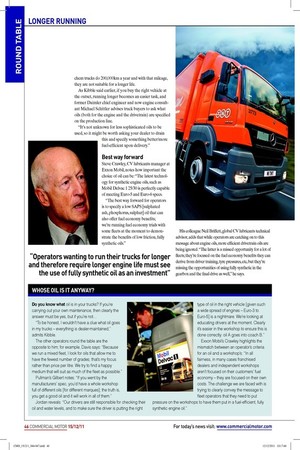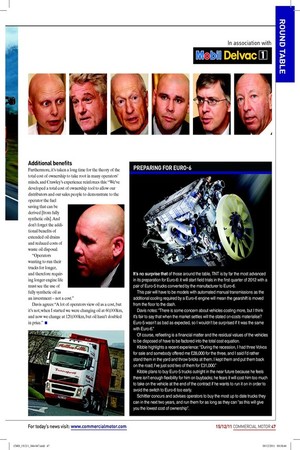Keep on running
Page 38

Page 39

Page 40

Page 41

If you've noticed an error in this article please click here to report it so we can fix it.
As the spectre of Euro-6 looms, operators may want to run Euro-5 trucks for longer. CM, with the help of Exxon Mobil, brought together some hauliers and specialists to discuss operating their vehicles for longer
Words: Justin Stanton / Images: Graham Richardson Over the past two years we’ve written scores of stories about Euro-6 and there is a common undercurrent in all of them: cost. Namely trucks that will be more expensive to buy up-front, heavier, more complex to maintain, and likely to be less fuel-eficient than the Euro-5 trucks they will supersede.
Euro-6 becomes mandatory for new registrations on 31 December 2013, and while that might still be two years away, ask yourself this: when are you planning to replace
▲ Justin Stanton your current trucks? If your
answer is anything from that date onwards, you’d better think again; it’s probably best to sell within the next two years and buy Euro-5, either new or nearly new, and run for ive, six or even seven years.
With this conundrum in mind, we brought together – with the help of Exxon Mobil – a handful of truck operators and a couple of technical specialists to discuss the merits of running trucks for longer.
On the face of it, running trucks longer is nothing new; over to Steve Davis, the award-wining national engineering manager at TNT Express Services: “If I go back to when I started, you ran a truck until it dropped and then you scrapped it.” He adds with a laugh: “Although hopefully you’d anticipate that!” But over the years, “the way the marketing machines of the truck manufacturers have worked meant you were replacing trucks sooner rather than later. The reality is that trucks are so well built these days that they’re quite capable of running on longer” , he says.
Still in service
Matthew Kibble, owner and director of former Motor Transport Haulier of the Year Matthew Kibble Transport, echoes Davis’s thoughts, highlighting his 11-yearold Volvo FH: “It was 12 months old when I bought it; it was the irst truck I bought – and it’s still in service today. It’s a bloody good vehicle and it’s got 1.4 million on the clock – it’s still going strong. I spent £5,000 on an engine rebuild three years ago. If you buy the right vehicle at the outset, they’re good for 10 years – Volvo, Scania. I’ve got some DAFs, but I wouldn’t say they were 10-year vehicles.” Ian Gilbert is general manager of Pullman Fleet Services, Wincanton’s servicing arm, and he backs up Kibble and Davis: “A lot of our customers are looking to run vehicles on longer. As a maintenance contractor, we’re looking at what we can offer our customers – better maintenance packages to run them longer for example, so looking at six or seven years, but excluding some of the major items [engines, gearboxes, etc].
“We’re also looking at doing healthchecks on vehicles, so when they get to ive years old, we start improving the maintenance cycle, for example, looking at oil sampling to give us a bit more in-depth knowledge than you can pick up on a routine service.” Davis takes a similarly matter-of-fact approach to longer-life trucks, noting that the planned maintenance inspections regime is strictly adhered to. He says: “We’re now running our trucks for longer and we haven’t seen a deterioration in reliability in those trucks.
Vehicle rotation
“However, we’ve deinitely suffered a slight fuel economy reduction: an older vehicle uses more fuel than a newer one. But we rotate vehicles on our hub-and-spoke system: the newer vehicles run on the longer spokes. Typically, a newer truck might do 20,000 to 30,000 more miles a year than an older one. If a vehicle becomes uneconomical, we dispose of it and rent [if it’s not the right time to buy].
“Certainly I’m quite comfortable with pushing out to six years on the linehaul leet because it’s relatively easy trunking, it’s not hard on components. I don’t see pushing out another year as a great problem.” Gilbert agrees: “As long as they’re maintained right, there’s no issue.” But he notes that Wincanton’s petro chem trucks do 200,000km a year and with that mileage, they are not suitable for a longer life.
As Kibble said earlier, if you buy the right vehicle at the outset, running longer becomes an easier task, and former Daimler chief engineer and now engine consultant Michael Schittler advises truck buyers to ask what oils (both for the engine and the drivetrain) are speciied on the production line.
“It’s not unknown for less sophisticated oils to be used, so it might be worth asking your dealer to drain this and specify something better/more fuel-eficient upon delivery.”
Best way forward
Steve Crawley, CV lubricants manager at Exxon Mobil, notes how important the choice of oil can be: “The latest technology for synthetic engine oils, such as Mobil Delvac 1 25/30 is perfectly capable of meeting Euro-5 and Euro-6 specs.
“The best way forward for operators is to specify a low SAPS [sulphated ash, phosphorus, sulphur] oil that can also offer fuel economy beneits; we’re running fuel economy trials with some leets at the moment to demonstrate the beneits of low friction, fully synthetic oils.” His colleague Neil Briffett, global CV lubricants technical advisor, adds that while operators are catching on to this message about engine oils, more eficient drivetrain oils are being ignored. “The latter is a missed opportunity for a lot of leets; they’re focused on the fuel economy beneits they can derive from driver training, tyre pressures, etc, but they’re missing the opportunities of using fully synthetic in the gearbox and the inal drive as well,” he says.
Additional benefits
Furthermore, it’s taken a long time for the theory of the total cost of ownership to take root in many operators’ minds, and Crawley’s experience reinforces this: “We’ve developed a total cost of ownership tool to allow our distributors and our sales people to demonstrate to the operator the fuel saving that can be derived [from fully synthetic oils]. And don’t forget the addi tional beneits of extended oil drains and reduced costs of waste oil disposal.
“Operators wanting to run their trucks for longer, and therefore requir ing longer engine life must see the use of fully synthetic oil as an investment – not a cost.” Davis agrees: “A lot of operators view oil as a cost, but it’s not; when I started we were changing oil at 60,000km, and now we change at 120,000km, but oil hasn’t doubled
in price.” ■



















































